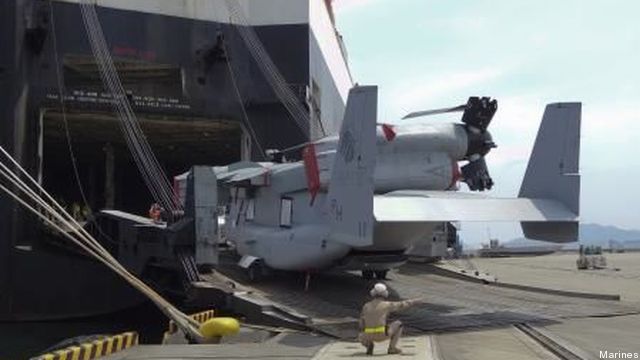Japanese Vice Defense Minister To Take Next Step In Dance Of The Osprey; Briefing On Moroccan Crash
Posted on

WASHINGTON: Japan’s vice defense minister, Hideo Jinpu, is to visit the Pentagon tomorrow to get a detailed briefing on the April 11 crash in Morocco of a Marine Corps MV-22 Osprey that killed two Marines. Jinpu’s visit is the next step in a kabuki dance that began a few weeks ago in response to Japanese protests against a Marine Corps plan to base Ospreys on Okinawa.
Japan’s government is bending over backward to prove to its public that it won’t let the Marines replace the 1960s-era CH-46E Sea Knight tandem-rotor helicopters it has on Okinawa now with the tiltrotor Osprey unless Japanese experts are satisfied the troop and cargo transport is safe. Japanese Defense Minister Satoshi Morimoto rode in an Osprey from the Pentagon to Quantico Marine Base and back during a visit Aug. 3, during which he reportedly did a lot of smiling and got home safely.
Japan’s limbo partner, the Pentagon, is bending over backward to placate the Japanese — and lowering the bar for sharing information about still-unreleased crash reports. Sources familiar with internal planning for the visit said Jinpu would be given a redacted copy of a Judge Advocate General Manual report on the crash — a document not yet released to the public.
Breaking Defense reported July 9 that investigators found that the pilot caused the Morocco crash by tilting his helicopter-airplane hybrid Osprey’s rotors too far forward at low airspeed, a violation of the MV-22 flight manual. The mistake was exacerbated by the fact that both he and the copilot failed to notice a 20-knot tailwind that contributed to the crash, the investigators found.
The Osprey’s reputation was stained by three fatal crashes during its 25-year development. After being redesigned and retested in 2002-2005, the MV-22 has proven itself one of the safest rotorocraft the Marine Corps flies. The Air Force Special Operations Command also flies a version of the Osprey and lost one of its CV-22’s in June to a crash at Eglin Air Force Base, Fla., in which no one was killed but five crew members were injured.
Panetta — an unabashed Osprey fan — said during Morimoto’s visit that, “When the government of Japan came to us and expressed safety concerns about the MV-22 deployment, we immediately responded in a deeply respectful, collaborative and a constructive manner.” A dozen Ospreys were shipped to Marine Corps Air Station Iwakuni on the Japanese mainland in July, but the U.S. had previously agreed they wouldn’t fly until the Japanese government had been given detailed information about the crashes in Morocco and Florida.
Wednesday’s briefing is just to cover the Morocco crash, but expect another Japanese visit to the Pentagon soon.
Subscribe to our newsletter
Promotions, new products and sales. Directly to your inbox.
